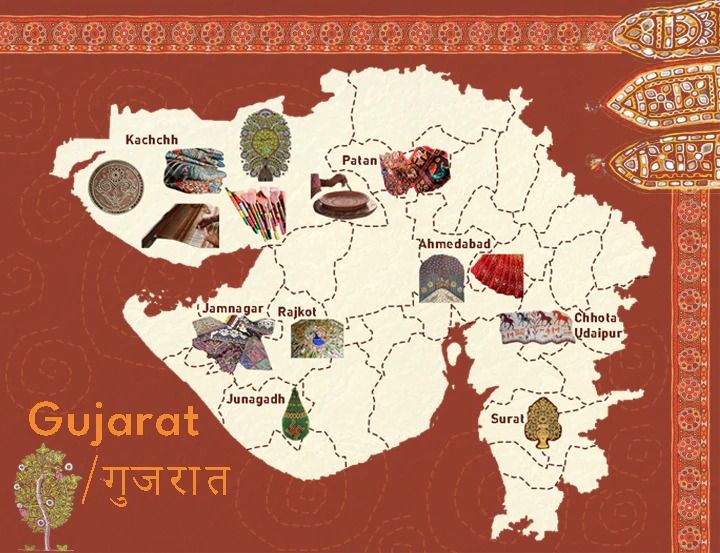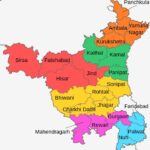Gujarat: A Complete Overview and Its Impact on Society
Introduction
Gujarat, a western state of India, is known for its rich cultural heritage, industrial prowess, and historical significance. It plays a crucial role in shaping India’s economy and cultural diversity. This article explores the history, significance, and contributions of Gujarat.
Gujarat is a state located on the western coast of India, known for its rich history, vibrant culture, industrial growth, and economic significance. It is one of India’s most important states in terms of trade, commerce, and tourism, and has a major influence on the country’s political landscape.
Geography & Demographics:
- Area: 196,024 sq. km (6th largest state in India).
- Population: Approximately 63 million (as per 2011 Census).
- Capital: Gandhinagar (administrative capital), while Ahmedabad is the largest city and the commercial hub.
- Major Rivers: Narmada, Sabarmati, Mahi, Tapi, and Godavari.
- Coastline: Gujarat has the longest coastline among Indian states, stretching over 1,600 kilometers along the Arabian Sea.
History & Culture:
- Ancient History:
- Gujarat has a rich historical heritage, home to ancient civilizations such as the Indus Valley Civilization (with significant sites like Dholavira).
- It has been part of many important empires in Indian history, including the Maurya, Gupta, and Chola empires.
- Medieval and Modern History:
- Gujarat was a prosperous region during the rule of the Solanki dynasty and later the Vijayanagara Empire.
- The state also played a crucial role in the Maratha Empire and was later under British colonial rule.
- Mahatma Gandhi, the Father of the Nation, was born in Porbandar, Gujarat, and played a pivotal role in India’s independence struggle. The Dandi March (Salt March) began from Gujarat in 1930.
- Cultural Heritage:
- Language: The official language is Gujarati, which is also widely spoken in the state.
- Festivals: Gujarat is known for its vibrant festivals such as Navratri (celebrating the worship of Goddess Durga with dance), Makar Sankranti, Diwali, and Janmashtami.
- Music and Dance: Garba and Dandiya Raas are famous traditional dance forms performed during the Navratri festival. The state is also known for its folk music and performing arts.
Economy of Gujarat:
Gujarat is one of India’s most economically developed and industrialized states.
- Industry and Trade:
- Gujarat has a thriving industrial sector, contributing significantly to India’s manufacturing and export activities.
- Key industries include petrochemicals, textiles, engineering, chemicals, ceramics, pharmaceuticals, and diamonds.
- The Kandla Port and Mundra Port are among the busiest ports in India, handling a significant portion of the country’s cargo.
- Gujarat International Finance Tec-City (GIFT City) is a leading financial and business hub.
- Agriculture:
- Gujarat is a major producer of cotton, groundnut (peanut), and tobacco, and also cultivates crops such as rice, wheat, and sugarcane.
- Horticulture and dairy farming are also significant sectors, with Amul, the world-renowned dairy cooperative, based in Anand, Gujarat.
- Energy and Infrastructure:
- The state is a major producer of solar energy and has extensive investments in renewable energy.
- Gujarat also boasts modern infrastructure, including well-developed highways, ports, and industrial zones.
- Tourism:
- Gujarat is known for its diverse tourism offerings, from ancient temples to beaches and wildlife sanctuaries.
- Rann of Kutch is famous for the Rann Utsav, a cultural festival of music, dance, and handicrafts.
- Historic cities like Ahmedabad, with its UNESCO World Heritage Site status, and Dwarka, an important pilgrimage center, attract both domestic and international tourists.
Governance & Politics:
- Current Chief Minister: Bhupendra Patel, who took office in 2021, from the BJP (Bharatiya Janata Party).
- Political Landscape:
- Gujarat has been a stronghold of the BJP for many years, with Narendra Modi, the current Prime Minister of India, serving as Gujarat’s Chief Minister from 2001 to 2014.
- The Indian National Congress (INC) has also been a significant player in the state, although it has lost ground in recent years.
- Regional parties, such as the Aam Aadmi Party (AAP), have also been gaining attention in recent times.
Key Sectors in Gujarat:
- Textiles:
- Gujarat is often called the “Manchester of the East” due to its extensive textile industry. It is a major center for cotton spinning, weaving, and garment production.
- The city of Surat is particularly famous for its diamond processing and textile industries.
- Diamond Cutting and Polishing:
- Surat is the world’s largest center for diamond cutting and polishing, and Gujarat is responsible for about 80% of the world’s diamond cutting.
- Automobile and Engineering:
- Gujarat has emerged as an automobile manufacturing hub, with factories of companies like Suzuki, Ford, and Tata Motors located here.
- The state also has a robust engineering and heavy machinery sector.
- Dairy and Food Processing:
- Amul, the largest dairy cooperative, and Sardar Patel, who is often credited with revolutionizing the dairy industry, play a central role in the state’s dairy sector.
- The state is also a leader in food processing, especially in areas such as sugar and oil extraction.
Tourist Attractions:
- Historic Sites:
- Rani ki Vav (a UNESCO World Heritage Site) and Modhera Sun Temple are examples of Gujarat’s architectural splendor.
- Dwarka (associated with Lord Krishna), Somnath Temple, and Akshardham Temple are significant religious sites.
- Nature and Wildlife:
- Gir National Park, home to the Asiatic lion, is one of Gujarat’s most famous wildlife reserves.
- Kutch is famous for the Rann of Kutch, a vast salt marsh, and the Great Rann Utsav, a cultural extravaganza.
- Marine National Park and Wildlife Sanctuaries like Blackbuck National Park in Velavadar are also popular.
Challenges:
- Water Scarcity: Despite its significant agricultural output, Gujarat faces challenges related to water scarcity and irregular rainfall, especially in rural areas.
- Environmental Issues: Industrial pollution and over-exploitation of resources are concerns, particularly in urbanized areas like Ahmedabad and Surat.
- Social Inequality: Despite impressive economic growth, disparities exist in terms of access to education, healthcare, and infrastructure, especially in rural areas.
History and Background
It boasts a long and illustrious history that dates back to ancient civilizations. Some key historical milestones include:
- Indus Valley Civilization: Lothal, one of the prominent cities of this ancient civilization, was located in Gujarat.
- Dynastic Rule: Mauryas, Guptas, Chalukyas, and Solankis contributed to Gujarat’s development.
- Medieval Period: Gujarat became a hub for trade under the Delhi Sultanate and the Mughals.
- British Era: Gujarat played a crucial role in India’s freedom struggle, being the birthplace of Mahatma Gandhi.
- 1960: Gujarat was formed as a separate state from Bombay State.
Political Significance
It has been a stronghold of political leadership and economic reforms. Some important aspects include:
- Economic Reforms: Policies that promote industrial growth and investments.
- Political Leadership: Home to influential political leaders and visionary leadership.
- Infrastructure Development: Rapid progress in urban planning and rural connectivity.
Daily Life and Its Impact
It’s influence on daily life is significant, with contributions in the following areas:
- Lifestyle: A blend of traditional values and modern aspirations.
- Economy: Industries like petrochemicals, textiles, and diamonds drive growth.
- Education: Premier institutions such as IIM Ahmedabad contribute to knowledge excellence.
- Healthcare: Well-developed healthcare facilities ensuring quality medical care.
Achievements and Contributions
It has achieved numerous milestones in various sectors, such as:
- Industrial Hub:
- Known as the ‘Petrochemical Capital of India.’
- Major automobile and pharmaceutical production centers.
- Cultural Heritage:
- Vibrant festivals like Navratri celebrated with grandeur.
- Rich handicrafts, traditional textiles, and folk art.
- Tourism Development:
- Iconic attractions like Gir National Park and the Rann of Kutch.
- Promotion of heritage tourism.
Importance in Indian Society
It plays a vital role in Indian society through:
- Economic Strength: A significant contributor to India’s GDP.
- Cultural Influence: Home to diverse traditions and communities.
- Innovation Hub: Encouragement of startups and industrial advancements.
Observance and Popularity
It’s traditions and observances attract millions of tourists every year, including:
- Festivals: Vibrant celebrations of Uttarayan and Navratri.
- Cultural Events: International Kite Festival and Rann Utsav.
- Religious Tourism: Dwarka and Somnath temples as major pilgrimage centers.
Interesting Facts
- It has the longest coastline in India, stretching over 1,600 km.
- It is the only home of the Asiatic Lion.
- The world’s largest oil refinery is located in Jamnagar.
How Impacts Society
Gujarat’s impact is evident in various aspects, such as:
- Providing employment opportunities through industrialization.
- Preserving cultural heritage through festivals and tourism.
- Promoting sustainability through renewable energy initiatives.
FAQs
Q1: What is famous for?
A: It is famous for its industrial growth, cultural festivals, and heritage sites.
Q2: What languages are spoken?
A: It is the official language, with Hindi and English widely spoken.
Q3: Is Gujarat a safe place to visit?
A: Yes, It is known for its hospitality and safety for tourists.
Wishing: How to Celebrate Its Essence
You can celebrate Gujarat’s essence by:
- Exploring its historical and cultural landmarks.
- Participating in its grand festivals.
- Supporting local artisans and craftsmen.
Conclusion
It is more than an industrial powerhouse; it is a land of rich heritage, cultural vibrancy, and economic prosperity. It continues to play a pivotal role in shaping India’s progress.










